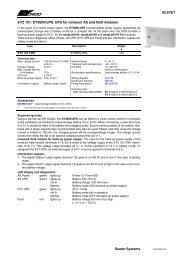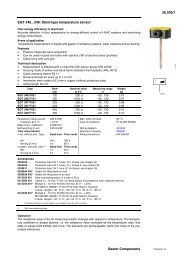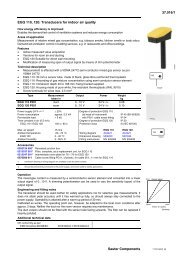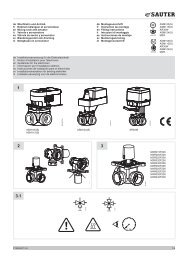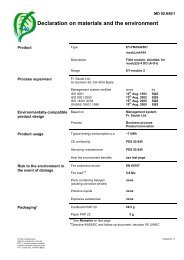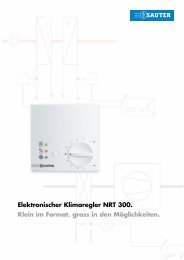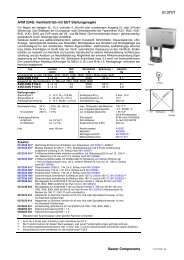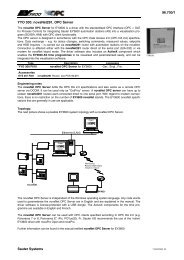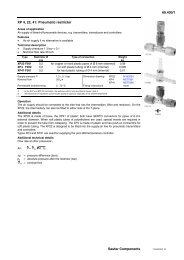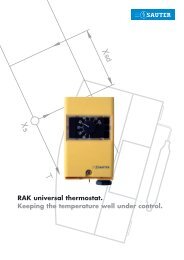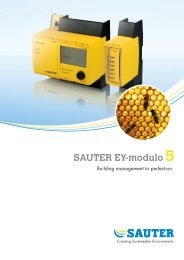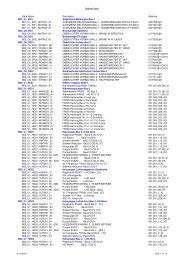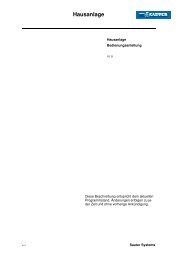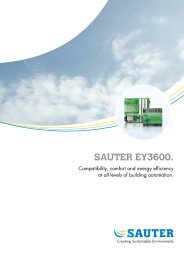Pneumatic duct-temperature controllers - sauter-controls.com sauter ...
Pneumatic duct-temperature controllers - sauter-controls.com sauter ...
Pneumatic duct-temperature controllers - sauter-controls.com sauter ...
Create successful ePaper yourself
Turn your PDF publications into a flip-book with our unique Google optimized e-Paper software.
67.004/2 TKP, TKFP, TKSP<br />
Operation<br />
Fixed-value' basic function: TKP 80 & TKP 81<br />
The bimetal sensor, which works on the bleed-off force-balance principle, converts the <strong>temperature</strong><br />
within its P-band into a pneumatic standard signal of 0,2 to 1,0 bar.<br />
Direction of operation A: the output pressure increases as the <strong>temperature</strong> rises.<br />
Direction of operation B: the output pressure decreases as the <strong>temperature</strong> rises.<br />
When the <strong>temperature</strong> is rising, the oil-filled sensor bends and, via the force-balance lever, exerts a<br />
force on the nozzle–ball system. An output pressure – proportional to the force of the lever – builds up<br />
between the external pre-valve and the nozzle–ball system. On the model with direction of operation B,<br />
the nozzle–ball system is on the other side of the lever.<br />
Instead of the external pre-valve, the models with type number 81 have an integrated pre-amplifier for<br />
systems with long lines or for drives with short running times; these require a connection for supply<br />
pressure.<br />
Fixed-value + schedule' extra function: TKFP 81<br />
On this model is a membrane cell below the force-balance lever. When this is pressurised by an external<br />
<strong>com</strong>mand signal, the setpoint X s can be shifted. When the <strong>com</strong>mand signal is 0,6 bar, then control<br />
is performed exactly to the pre-set setpoint. The setpoint elevation works on a <strong>com</strong>mand signal of 0,6<br />
to 1,2 bar = 0 to +6 K; while the setpoint setback works between 0,6 and 0 bar = 0 to –6 K. Models with<br />
this setpoint shift have an ‘F' in the model code and require a connection for <strong>com</strong>mand pressure.<br />
Sequence' extra function: TKSP 80 & TKSP 81<br />
This model has a nozzle–ball system on both sides of the force-balance lever. It requires two external<br />
pre-valves and has two outputs: one each for both directions of operation (A and B). This provides a<br />
sequence curve with the setpoint in the middle of the neutral zone X t . Models with the sequence function<br />
have an additional `S' in the model code.<br />
Key<br />
S = slope, setpoint shift T R = room <strong>temperature</strong><br />
FF = shift starting point, setpoint of the scheduling relay X p = P-band<br />
X S = setpoint X t = dead zone<br />
T A = outside <strong>temperature</strong> p A = output pressure<br />
p W = <strong>com</strong>mand pressure<br />
Sauter Components<br />
7167004003 04



